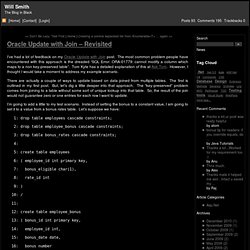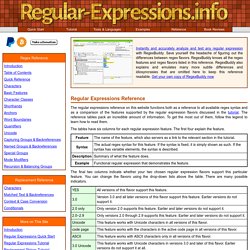

Chapitre 14. HQL: Langage de requêtage d'Hibernate. Hibernate uses a powerful query language (HQL) that is similar in appearance to SQL.

Compared with SQL, however, HQL is fully object-oriented and understands notions like inheritance, polymorphism and association. You can also assign aliases to associated entities or to elements of a collection of values using a join. For example: from Cat as cat inner join cat.mate as mate left outer join cat.kittens as kitten from Cat as cat left join cat.mate.kittens as kittens from Formula form full join form.parameter param The supported join types are borrowed from ANSI SQL: Les constructions des jointures inner join, left outer join et right outer join peuvent être abbrégées. from Cat as cat join cat.mate as mate left join cat.kittens as kitten Nous pouvons soumettre des conditions de jointure supplémentaires en utilisant le mot-clef HQL with.
Oracle Update with Join – Revisited. I’ve had a lot of feedback on my Oracle Update with Join post.

The most common problem people have encountered with this approach is the dreaded “SQL Error: ORA-01779: cannot modify a column which maps to a non key-preserved table”. Tom Kyte has a detailed explanation of this at Ask Tom. However, I thought I would take a moment to address my example scenario. There are actually a couple of ways to update based on data joined from multiple tables. The first is outlined in my first post. I’m going to add a little to my test scenario. 1: drop table employees cascade constraints; 2: drop table employee_bonus cascade constraints; 3: drop table bonus_rates cascade constraints; 5: create table employees.
Java. Console. SQL Functions. SQL functions are built into Oracle Database and are available for use in various appropriate SQL statements.

Do not confuse SQL functions with user-defined functions written in PL/SQL. If you call a SQL function with an argument of a datatype other than the datatype expected by the SQL function, then Oracle attempts to convert the argument to the expected datatype before performing the SQL function. If you call a SQL function with a null argument, then the SQL function automatically returns null. The only SQL functions that do not necessarily follow this behavior are CONCAT, NVL, REPLACE, and REGEXP_REPLACE. In the syntax diagrams for SQL functions, arguments are indicated by their datatypes. The sections that follow list the built-in SQL functions in each of the groups illustrated in the preceding diagrams except user-defined functions.
Single-Row Functions Single-row functions return a single result row for every row of a queried table or view. Numeric Functions Datetime Functions. Regular Expressions Reference - Basic Syntax. The regular expressions reference on this website functions both as a reference to all available regex syntax and as a comparison of the features supported by the regular expression flavors discussed in the tutorial.

The reference tables pack an incredible amount of information. To get the most out of them, follow this legend to learn how to read them. The tables have six columns for each regular expression feature. The first four explain the feature. The final two columns indicate whether your two chosen regular expression flavors support this particular feature. When this legend says "all versions" or "no version", that means all or none of the versions of each flavor that are covered by the reference tables: For the .NET flavor, some features are indicated with "ECMA" or "non-ECMA". For the std::regex and boost::regex flavor there are additional indicators ECMA, basic, extended, grep, egrep, and awk. For the PCRE2 flavor, some replacement string features are indicated with "extended".